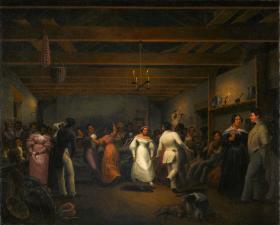1. Provide each student with a copy of the attached Image Analysis Chart. Have the class examine Kitchen Ball at White Sulphur Springs, Virginia and Plantation Burial. Encourage students to record their observations on the Image Analysis Charts.
2. Divide the class into pairs. Assign each pair of students to complete one Image Analysis Chart by combining their individual observations to create the best possible Image Analysis Chart. Allowing students to look at their Image Analysis Charts, hold a whole-class discussion focused on the following questions:
• What are the similarities and differences in the paintings?
• What do the paintings tell the viewer about slavery in the United States?
• What do the paintings fail to tell the viewer about slavery in the United States?
• Why did each artist choose to paint this particular image of slavery?
• How did the artist use the composition of the painting to influence the viewer's feelings?
• How do these images relate to power and identity?
3. Give students some background information about slavery in the United States. Select a short video from the PBS series Africans in America and see the related teacher resource guide for additional information about the program.
4. Provide each student with a sheet of white paper and markers or colored pencils. Assign each student to illustrate a representation of slavery in 19th-century America. Students should be asked to consider symbols, people, and things as well as colors that would influence the composition of their illustration. Allow the students to post their illustrations.
5. Hold a whole-class discussion focused around several students' brief presentations of what they portrayed in their illustrations and why they emphasized those things. Have students compare/contrast their own representations with Christian Mayr’s painting.
6. If time allows, have students compare their work and the Mayr painting to Forward, Jacob Lawrence’s image of Harriet Tubman. Consider the ways power and identity play a role in all of the images.
• The teacher will use the Image Analysis Charts, illustration, and class discussion to determine students’ understanding of the ideas and culture that influenced white artists in their portrayal of African American slavery.
• The teacher will use the illustration and class discussion to assess students’ ability to analyze how economic, cultural, political, and social factors influenced the institution of slavery and patterns of migration in the United States.
• The teacher will use the Image Analysis Charts to assess the students' analysis of the composition and content of visual sources.
• The teacher may use an art rubric to assess the students' illustrations.
composition
content
illustration
mood
portray
portrayal
portrayed
representations
setting
subject
symbols
white paper, colored pencils, markers, or crayons
To compare with a 20th-century interpretation of slavery, representing an occurrence in the life of Harriet Tubman:
Jacob Lawrence, Forward, 1967
IMAGINING AFRICAN AMERICANS IN AMERICAN ART
Early Representations of African Americans
Until the 20th century, with a few exceptions, black artists were barred from the mainstream art world, and the lives of African Americans were largely ignored as subject matter. With these historical boundaries in mind, consider a painting from before the Civil War that depicts African Americans.
Kitchen Ball at White Sulphur Springs, Virginia is one of the most important images of African American life from before the Civil War. Significantly, it was painted by a white man. Christian Mayr was born and trained in the German city of Nuremberg and came to America probably as a young man. He specialized in genre pictures or scenes of everyday life but earned his living as a portrait painter, traveling up and down the eastern seaboard in search of patrons. It is no surprise, then, that in the summer of 1838 we find him at the resort of White Sulphur Springs, in the mountains of Virginia (later West Virginia). The resort, a favorite summer retreat for plantation families from the steamy Carolina low country, teemed with potential patrons. What is surprising, though, is how Mayr apparently ignored them all and focused his attention on their servants.
Though rare, slave balls were not unheard of in the South. Sponsored by white masters, for their more privileged slaves, these festivities adopted the genteel social conventions of white society. Why do you think this particular celebration was held? Our best guess is the obvious one: it is a wedding, the bride and groom, both in white, step to a vigorous dance, accompanied by musicians playing flute, fiddle, and cello. Other couples join in the dancing while onlookers crowd around.
The painting is remarkable on several counts. First, it is almost unique in its depiction of slave life in the antebellum South. Despite its pervasiveness in southern culture, slavery was virtually ignored in art. Why? Was it just too horrific? Would it have made the viewer uncomfortable? Would it have provoked unwelcome questions? It is difficult to answer these questions with certainty today.
The second remarkable thing about this painting is the way it depicts slaves, without the crude caricatures typical of the time. Mayr portrays individuals, old and young, thin and stout, some with dark complexions, others lighter skinned. Painting more than 20 years before the Civil War, the artist grants his subjects a full ration of humanity--and this at a time when the U.S. Constitution recognized slaves as having only three-fifths the value of whites.
Then there is a more complex and disturbing interpretation, one that insists on the crucial but easily overlooked fact that everyone in this jolly company is in bondage. They are slaves, well fed and well dressed for sure, but still slaves. So, two questions can be asked: in depicting the polite revels of a privileged class of slaves, was the artist not willfully skirting the harsh reality of slavery? Was he, in fact, softening that harshness, making slavery palatable to polite white society?


